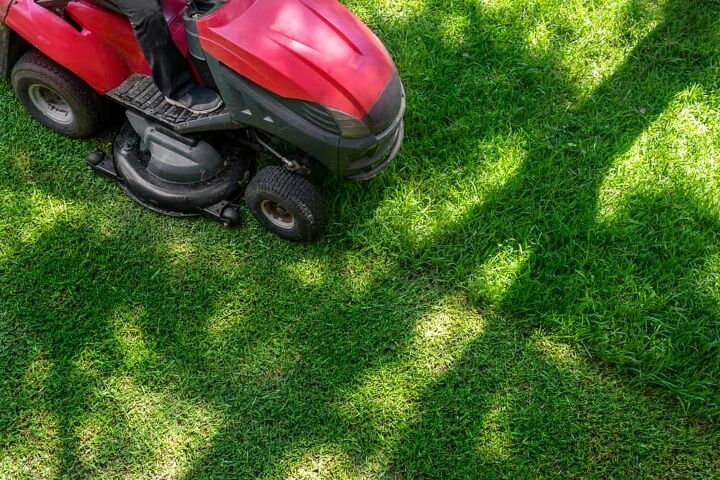Craftsman Riding Mower Won't Start And Just Clicks? (Fix It Now!)

Riding mowers are a great piece of machinery to have especially if you have to mow a large property. They come in a wide variety of styles, depending on the brand. For example, Craftsman is a famous brand that makes riding mowers. However, what happens when your Craftsman riding mower clicks but won’t start?
If your Craftsman mower is clicking but won’t start, check for a dead battery. If the battery is okay, then look for issues in the connections to the battery, the solenoid, starter motor, as well as the engine. If you cannot find the problem, you can always take it to a professional for repair.
This article will act as a guide and take you through each scenario so that you can determine what’s wrong with your Craftsmen mower. That way, you can fix the issue and get back to mowing and towing. Let’s get started, shall we?
Do You Need a Mower Repair Service?
Get free, zero-commitment quotes from pro contractors near you.

Why Does My Craftsman Riding Mower Click But Won’t Start?
This is a prevalent issue, especially in the springtime when you are getting your mower back out of the shed after winter. In general, it’s effortless to put right, and after a few simple checks, you’ll soon be able to start cutting your grass again.
The most common reason that your riding mower won’t start, and just clicks, is a dead battery. There are several other possibilities, including:
- Dirty battery connections
- Loose battery connections
- Solenoid fault
- Binding starter motor
- Excessive valve lash
- Hydro-locked engine
- Faulty ignition switch
- Faulty starter
- Engine seizure
That may seem like a wide variety of possibilities, but there’s no need to check all of them. The issue likely is one of the first three. Let’s examine the possible causes in order of probability.
Faulty Battery Connections
Faulty battery connections are also very common and cause a slew of starting issues with Craftsman riding mowers. These faulty connections can prevent power from being transferred from the battery to the cables, as they’re loose, dirty, or damaged.
Loose Connections
Riding lawn mowers vibrate a lot, which can cause connections to loosen. It’s a good practice to check and service your mower after a period when it’s not been used, even if it seems to be running well.
Dirty Connections
Dirty connections are typically caused by leaks of battery acid at the battery poles. Crystallized acid causes high resistance. Look for signs of a white chalky substance building up on the connectors.
Cleaning Connections
An easy way to clean the connections is to mix a couple of spoons of baking soda with a small quantity of water, creating a thick paste. Wear gloves and protective eye-wear. Use this to neutralize and remove the crystallized acid on the connections and battery poles.
Next, detach the connectors and clean well with a wire brush or sandpaper. Finally, coat with a fine layer of petroleum jelly to discourage future accumulation. Due to the vibrations experienced by mower blades and engines, it’s not surprising that bolts can be shaken loose. Ensure that both the positive (RED+) and negative (BLACK-) are secure and dirt-free.
Cables
Mice seem to love chewing through cables, so from time to time, check them for damage. The damage can present as fraying or breakage in the wire. Also, sometimes it will appear to be stripped, which indicates that mice are eating your wires.
Battery
A flat battery can be frustrating. The quickest way to deal with it is to jump-start the mower. Before trying a jump-start, check that the battery isn’t leaking. If it is, and it’s a sealed battery, you’ll need a replacement.
However, usually, only wet batteries leak. The best thing to do is to check the electrolyte level and add more if required. Use proper safety precautions, i.e., gloves, eye protection, etc. The purpose of PPE is to avoid acid burns to your skin and eyes. It’s just not worth risking accidents by taking short-cuts.
If there is significant leakage, don’t attempt a jump-start; replace the battery. It’s not difficult to install a new battery; ensure it’s the correct size and that the poles are correctly positioned.
Buying A Battery
If you’re buying a battery, be aware that wet batteries will only be shipped without acid, so you’ll need to purchase it separately, then fill and charge. To avoid that hassle, it’s better to choose a gel, or sealed battery, which will be maintenance-free. These can be shipped, fully-charged, and ready to use.
Battery Charging
Your battery can quickly become depleted over the winter. A battery charger can help avoid this. A trickle/smart charger is easy to use. Just attach the color-coded crocodile clips and connect them to a power source. Leave until you’re ready to use the mower in spring, and you’ll be good to go.
Solenoid
Though cheap, easy to fit, and easy to find, solenoids do cause a lot of problems. However, there are ways to test it before taking on a project that may not be necessary.
Faulty Solenoid
A solenoid is a kind of large relay. Its function is to connect the battery and the starter motor, so the engine will crank while holding the key in place.
A clicking noise indicates that the solenoid is attempting to work by pulling in the armature and failing. This is very common, so don’t be surprised if yours needs replacing. There can be other reasons for the click, though there are less usual. These need to be correctly diagnosed, or else you may find that replacing the solenoid hasn’t resolved the issue.
Solenoid Location
Sometimes even finding the solenoid can be a challenge. If it’s not under the hood, it may be behind the gas tank, under the seat, or the back wheel.
The quickest way to locate it is to track the red cable from the battery. On specific models, especially Kawaski and Honda engines, the solenoid will be housed in the same unit as the starter.
Husqvarna prefers to position theirs below the back wheel fender or below the dashboard, at the side of the steering column. Craftsman positions them in different places depending on the model, so you will need to check your owner’s manual before proceeding.
Binding Starter Motor
The gear head of the starter motor can get jammed against the flywheel. This will bind the engine and starter motor together. That’s why when you try to switch on the ignition, there’s a clicking sound.
Testing
Testing to see if the starter motor is bound can be carried out by turning the engine over by hand, anti-clockwise. Specific engines have a covered flywheel. In this case, try rotating the crankshaft using a ratchet and socket, accessing it from below.
If the motor is freed when turning anti-clockwise, binding is the cause of the issue. Typically, you can fix it by spraying some WD40 on the starter gear head. Take care with the straw to direct the lubricant onto the gear head, so you don’t have to remove any covers.
Hydro-locking
If the carburetor float needle seals are worn, they may cause gas to leak into the cylinder. Hydro-locking means that the cylinder is filled with gas, so the piston can’t move, and the engine will click when you try to start it.
Detaching the spark plug and turning the engine will expel the gas, but you will need to replace the carburetor and change the engine oil.
Look out for these other signs that the carburetor needle seal is leaking: an over-full oil level; white smoke coming from the muffler; an oil leaking originating the muffler; gas dripping from carburetor; or a strong smell of fuel in the garage.
Leaking Seal
Seal failure is typical in older carburetors due to the wear and tear of the rubber needle. Thus, fuel keeps filling the carburetor, which eventually seeps into the cylinder and crankcase.
Gas In The Oil
If there’s gas in your oil, don’t make the mistake of running the mower. Diluted oil won’t protect the engine components. Resolve the issue by installing a new carburetor and changing the oil.
Internal Engine Damage
If none of the above fixes has solved the problem, it may indicate that something more serious is in play. Riding mowers are typically strong and durable but, in rare cases, may become damaged.
For example, con rods can penetrate engine casings; the main bearing can seize up; the con rods can be damaged, and bent or the cylinder head can fail. While some of these can be put right, others make it frankly uneconomical to try and fix the machine.
New Engine
If your engine has broken down and can’t be fixed, the solution is to buy a completely new engine. Ensure you choose one with a good warranty against manufacturing defects. They are usually easy to install, just needing four bolts, two electrical connectors, a fuel line, throttle cable, a crank pulley, and engine oil (you’ll have to supply this separately). The job can be carried out in under 2 hours.
Do You Need a Mower Repair Service?
Get free, zero-commitment quotes from pro contractors near you.

Our Takeaway
Riding mowers are an excellent addition to your landscaping tools; however, they can be frustrating when they won’t start. But, more often than not, this is an indication of a bad battery or faulty connection. Use this guide to check various potential causes so that you can get back to mowing your lawn in no time.

Heather is a passionate writer who loves anything DIY. Growing up, she learned everything from home repairs to design, and wants to share her tips with you. When she's not writing, she's usually hiking or searching for her next DIY project.
More by Heather Robbins













![The 5 Best Angle Grinders – [2022 Reviews & Buyer's Guide]](https://cdn-fastly.upgradedhome.com/media/2023/07/31/9071326/the-5-best-angle-grinders-2022-reviews-buyer-s-guide.jpg?size=350x220)













